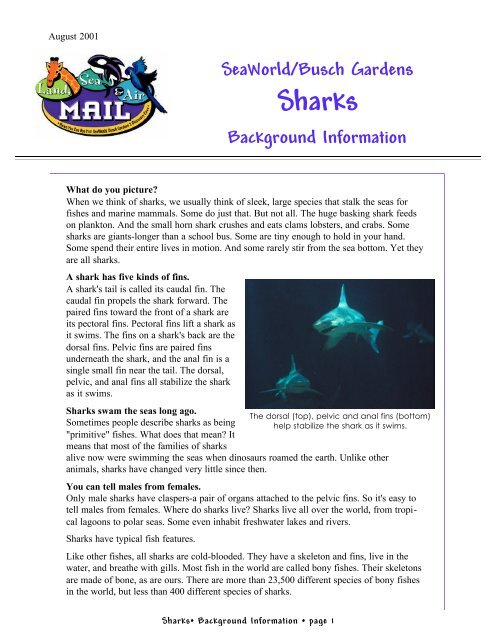SeaWorld/Busch Gardens Sharks Background Information
SeaWorld/Busch Gardens Sharks Background Information
SeaWorld/Busch Gardens Sharks Background Information
Create successful ePaper yourself
Turn your PDF publications into a flip-book with our unique Google optimized e-Paper software.
August 2001<br />
<strong>SeaWorld</strong>/<strong>Busch</strong> <strong>Gardens</strong><br />
<strong>Sharks</strong><br />
<strong>Background</strong> <strong>Information</strong><br />
What do you picture?<br />
When we think of sharks, we usually think of sleek, large species that stalk the seas for<br />
fishes and marine mammals. Some do just that. But not all. The huge basking shark feeds<br />
on plankton. And the small horn shark crushes and eats clams lobsters, and crabs. Some<br />
sharks are giants-longer than a school bus. Some are tiny enough to hold in your hand.<br />
Some spend their entire lives in motion. And some rarely stir from the sea bottom. Yet they<br />
are all sharks.<br />
A shark has five kinds of fins.<br />
A shark's tail is called its caudal fin. The<br />
caudal fin propels the shark forward. The<br />
paired fins toward the front of a shark are<br />
its pectoral fins. Pectoral fins lift a shark as<br />
it swims. The fins on a shark's back are the<br />
dorsal fins. Pelvic fins are paired fins<br />
underneath the shark, and the anal fin is a<br />
single small fin near the tail. The dorsal,<br />
pelvic, and anal fins all stabilize the shark<br />
as it swims.<br />
<strong>Sharks</strong> swam the seas long ago.<br />
Sometimes people describe sharks as being<br />
"primitive" fishes. What does that mean? It<br />
means that most of the families of sharks<br />
alive now were swimming the seas when dinosaurs roamed the earth. Unlike other<br />
animals, sharks have changed very little since then.<br />
You can tell males from females.<br />
Only male sharks have claspers-a pair of organs attached to the pelvic fins. So it's easy to<br />
tell males from females. Where do sharks live? <strong>Sharks</strong> live all over the world, from tropical<br />
lagoons to polar seas. Some even inhabit freshwater lakes and rivers.<br />
<strong>Sharks</strong> have typical fish features.<br />
Like other fishes, all sharks are cold-blooded. They have a skeleton and fins, live in the<br />
water, and breathe with gills. Most fish in the world are called bony fishes. Their skeletons<br />
are made of bone, as are ours. There are more than 23,500 different species of bony fishes<br />
in the world, but less than 400 different species of sharks.<br />
<strong>Sharks</strong>• <strong>Background</strong> <strong>Information</strong> • page 1<br />
The dorsal (top), pelvic and anal fins (bottom)<br />
help stabilize the shark as it swims.
So what's the difference?<br />
One thing that makes sharks different from bony fishes is that a shark's skeleton is made of<br />
cartilage, not bone. Cartilage is a tough connective tissue. We have cartilage in parts of our<br />
bodies, too. Push on your nose or squeeze your ear to feel cartilage.<br />
Another difference between sharks and bony fishes is their scales. Most bony fish scales<br />
are round, and as the fish grows, so do its scales. In fact, you can estimate how old some<br />
fish are by counting the rings in their scales, just like counting tree rings. Shark scales are<br />
different. Each one looks like a miniature tooth. And they have the same structure as a<br />
tooth: an outer layer of enamel, a layer of dentine, and a pulp cavity. <strong>Sharks</strong>' scales don't<br />
grow bigger as the shark ages. As a shark grows, it grows more scales. These toothlike<br />
scales make a shark's skin rough, like sandpaper.<br />
<strong>Sharks</strong> have lots of teeth.<br />
A shark has several rows of teeth in its mouth.<br />
<strong>Sharks</strong> bite with the outer row of teeth, but<br />
eventually these teeth fall out. A tooth from the<br />
row behind moves up to take its place. Another<br />
difference between sharks and bony fishes is that<br />
sharks grow new teeth all the time. Some sharks<br />
may go through as many as 30,000 teeth in a lifetime.<br />
Think of a batoid as a flat shark.<br />
The closest relatives of sharks are called batoids.<br />
Like sharks, they have toothlike scales and skeletons<br />
made of cartilage. What makes them different<br />
from sharks is that their bodies are flat, and the<br />
front fins are fused with the head. Some batoids,<br />
like stingrays, have one or more venomous spines<br />
on a whiplike tail. The sharp spine can deliver a<br />
painful sting.<br />
What do sharks eat?<br />
Some sharks are probably not very picky about what they eat. But certain kinds of sharks<br />
eat some foods more than others. Hammerhead sharks eat mostly stingrays. Smooth dogfish<br />
eat mostly crabs and lobsters. Tiger sharks eat mostly sea turtles. Blue sharks eat<br />
squids. And whale sharks eat plankton.<br />
Many sharks prey most often on the weakest members of a population. <strong>Sharks</strong> eat weak,<br />
ill, or injured animals because they are the easiest to catch.<br />
These predators have poor appetites.<br />
<strong>Sharks</strong> eat far less than most people imagine. Remember that, like other fishes, sharks are<br />
cold-blooded. Cold- blooded animals have much lower metabolisms than warm-blooded<br />
animals such as mammals. So sharks don't need huge amounts of food. A shark probably<br />
eats between 1% and 10% of its body weight in a week, and many sharks probably go several<br />
weeks between meals.<br />
Who needs silverware?<br />
Think of a shark's lower jaw teeth as a fork, and its upper jaw teeth as a knife. As a shark's<br />
jaws extend to bite its prey, teeth of the lower jaw puncture and hold prey. The upper jaw<br />
teeth slice. A shark's short jaws make the bite powerful.<br />
<strong>Sharks</strong>• <strong>Background</strong> <strong>Information</strong> • page 2<br />
Most shark teeth are triangular in<br />
shape and have serrated edges.
<strong>Sharks</strong> don't eat people...very often.<br />
Only 32 (of nearly 400) kinds of sharks have ever been known to attack people. Like other<br />
wild animals, most sharks would rather avoid you. <strong>Sharks</strong> that have attacked people probably<br />
mistook them for food or may have attacked to protect their territory.<br />
As a group, sharks and batoids have several predators, including other sharks, elephant<br />
seals, and killer whales.<br />
People are predators too.<br />
Over the years, people have used sharks for food, medicines, vitamins, weapons, jewelryeven<br />
sandpaper. But today some species are in trouble. Why? Shark meat has become a<br />
more popular food. Also each year, thousands of sharks are caught accidentally as bycatch,<br />
snagged in nets set out to catch other types of fish. The number of sharks taken this way<br />
can equal or exceed the number of sharks taken intentionally. A particularly wasteful practice<br />
is shark finning-removing only the fins and tossing back the rest of the shark to die at<br />
sea.<br />
<strong>Sharks</strong> can't bounce back.<br />
<strong>Sharks</strong> grow very slowly compared to other fishes. A female shark produces at most only a<br />
few hundred pups in her lifetime, compared with millions of offspring produced by other<br />
fishes. Depleted shark populations may take years to recover.<br />
The more we learn about sharks and their<br />
behavior, the better we can understand and<br />
manage shark populations.<br />
Go fish wisely.<br />
The United States is a world consumer and<br />
trader of shark meat. The National Marine<br />
Fisheries Service has developed management<br />
plans for 39 shark species in the<br />
Atlantic Ocean, Caribbean Sea, and Gulf of<br />
Mexico. While there is no federal management<br />
of sharks in Pacific waters, California<br />
and Alaska regulate shark fishing. Such<br />
plans and regulations address issues such as<br />
bycatch and include setting catch limits and<br />
closed seasons. Finning is prohibited in<br />
Alaska, California, and Atlantic waters.<br />
What can we do to help?<br />
Conservation begins with learning.<br />
Research into shark reproduction helps us<br />
understand shark population dynamics. And<br />
when we understand shark populations, we can better plan for the future of sharks.<br />
Keeping the ocean clean and adhering to fishing regulations are more ways we can help.<br />
(Visit your local bait and tackle shop or contact your state's Fish and Game Department for<br />
information on fishing regulations in your state.)<br />
Animal Migration • <strong>Background</strong> <strong>Information</strong> • page 2













